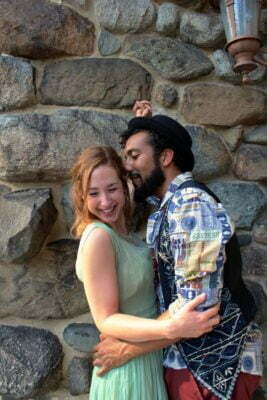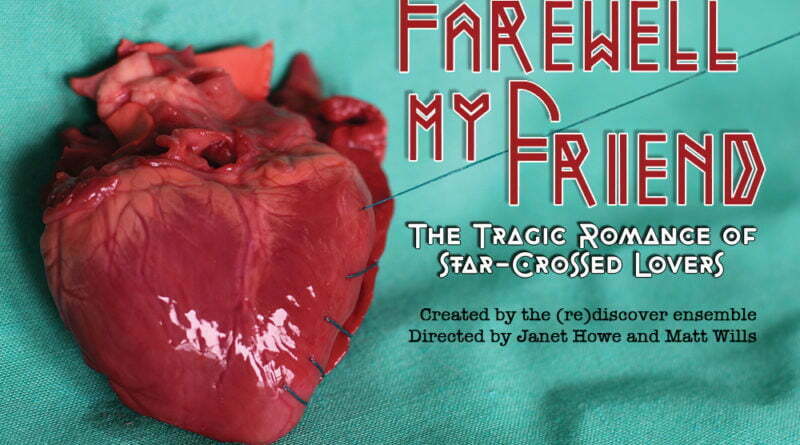Farewell My Friend: The Tragic Romance of Star-Crossed Lovers
Created by the (re)discover ensemble.
Directed by Janet Howe & Matt Wills.
Produced by (re)discover theatre.
Playing at Epworth Church, Chicago.
“Follow your heart.”
An Immersive, Movement-Based Experience That Moves Everything But the Heart.
Farewell My Friend, (re)discover theatre’s newest iteration of their immersive production of the same name that premiered last year, is the first Chicago “new work” I was actually excited to see. Finding myself in the midst of my own quasi-tragic romance, I anticipated relishing in the rich pathos of not one but two timeless romantic tragedies of “star-crossed lovers,” Shakespeare’s Romeo and Juliet and the popularized legend of Tristan and Iseult; moreover, absent any contemporary socio-political angle on the stories, I expected to enjoy the production all the more for its emotional purity. In other words, the stars were aligned for me to love this production.

However, like a lover whom one loves at a distance only to discover upon intimate encounter that they fall short of one’s idea, (re)discover theatre’s Farewell My Friend left me disappointed and forlornly bereaved. An immersive experience with heavy emphasis on movement-based storytelling and emotation, Farewell My Friend dances and gesticulates dangerously close to melodrama and parody in its unaffecting and bewildering physical mash-up of two well-known tragic romances.
Farewell My Friend begins with an intriguing set-up. When I first entered the “theatre space” (one of many locations inside the church that were used for performance), Lady Montague (Shariba Rivers) greeted me and invited me to pick a card from a deck: the card you choose, whether Montague or Capulet, will determine your “house,” which in turn will determine the storyline you will follow throughout the show (I was a Montague, don’t hate). This, however, is not mandatory, as you are free to “follow your heart” along any path or with any character you like.
After briefly waiting in this first room — an environment suggestive of the others, with pleasantly evocative piano music and hanging candelabras — the lights dimmed and the entire cast of characters energetically flooded in and began intermingling with the audience, greeting one-another in-character and periodically lapsing into slow-motion to showcase specific characters, their personalities and relationships, in spot-lit vignettes. I took this to be an introduction of sorts, although I wasn’t in a position to see or hear everything that was happening (a problem I found with many of the scenes, though one that the production anticipates in its advertisement of “repeat viewings”).

After this opening “scene,” the audience was ushered, by house, into different rooms, and from this point on your experience will differ greatly from another’s (for the most part, only during the first and last scenes is the audience all together). Before I had arrived, I had set my heart to follow after Iseult’s storyline; however, it became apparent in my second room (the church proper) that virtually the entirety of the Tristan (Zachary Schley) and Iseult (Karissa J. Murrell Myers) story is told through physical movement. But while I sat in the church pew and watched the simultaneous progressions of both stories’ first scenes, I quickly lost interest in the Tristan and Iseult storyline because the movements were neither evocative nor suggestive of much. Therefore did I turn my heart toward Romeo (Raj Bond) and Juliet (Tara Bouldrey), satisfied to at least have Shakespeare’s text to guide me.
Yet, as sure and eloquent a guide as Shakespeare’s text is, and as familiar as I am with the story, I found even Romeo and Juliet’s story difficult to connect with emotionally — not to mention confusing to follow. I was able to watch most of the story’s pivotal scenes (only once getting lost in a room where some non-principal Capulets were dancing — for want of anything better to do, I suppose), but even with having witnessed the majority of the story I felt disconnected by the overly emotive performances and discombobulated by the constant change of rooms (which occurs at least once every ten minutes). And so, failing to make any strong, emotional connection with either the characters or their stories, I soon found myself withdrawing internally to that place where one looks out at what one beholds with disengaged and apathetic irony — obviously not the right place for romance.
This, of course, only aggravated the rest of my experience — and it certainly didn’t help that the last half-hour of the production introduces even more physical choreography. Following the two murders of Mercutio (Kelly Schmidt) and Tybalt (Ray Rehberg) — two characters I could no more identify than care for — and a random, séance-like ritual conducted by Lady Montague (Why? No idea.), the action moved to the church basement. Here were several more rooms. The first one I looked in on had Tristan navigating a web of yarn while, in the background, a pre-recorded video showed a pair of hands (Iseult’s?) rubbing themselves under a stream of gooey, white liquid. The meaning? Highly suggestive, yes, but ultimately indecipherable — and, again, absurdly unmoving.

After Tristan escaped his web (by simply crawling underneath it), I followed him to another room (as you can tell, I gave up on Romeo and Juliet). This room was papered with crumpled notes — on the walls, over the lights, piled in the corners — on which words were written, the origin of which eluded me: suffice it to say they were related to love. Tristan had a difficult time in this room: after writing a lovely note to Iseult and pasting it to the wall with the help of an audience member, King Mark (Wesley Gaines McNair) entered; after performing some elaborate, bro-mantic handshake, King Mark caught on to what Tristan was doing (i.e. his wife, Iseult) and practically imploded before gruffly exiting. This prompted Tristan to writhe on the ground until Romeo entered and the two shared in their agony together: as they each began repeating a phrase from one of the notes on the wall, they repeatedly clapped themselves on their shoulders, shook their bodies, and jumped and turned in place — literally, a kind of modified, flagellatory Moccarana. Needless to say, I was unimpressed.
The last room I visited in the church basement featured the penultimate, double-suicide scene from Romeo and Juliet. No surprises here: under a large, paper chandelier art installation (a la Christina Parreño’s “Paper Chandelier,” 2013), Romeo and Juliet’s tragic last moments transpire, as written. Only there are no lessons, no explanations by Friar Lawrence (Sister Lawrence, Almanya Narula) or Balthasar (Paul Hovey), and no final resolution between Montagues and Capulets (although perhaps they occurred elsewhere?). In any case, the production concluded in the first room, where the last thing the audience sees is Romeo and Juliet, both dead, holding each other in an eternal embrace as they look on Tristan and Isuelte with sympathetic smiles.
While the time and energy that must have gone into this production is evident enough in the elaborate, multi-room staging and the many choreographed dances and fights, the thought that went into it is not. Although highly original and brave in their theatrical feat, somewhere along the line Directors Janet Howe and Matt Wills lost the heartful substance of their project in the immersive form and esoteric concepts of their choreographed design. Farewell My Friend may be a re-discovery of two old stories, but, if not for pathos, for what end?
Even the simple questions of why and wherefore these two stories are told together is never clearly answered. Aside from their obvious thematic and plot connections, one ponders something like the eternal qualities of their woefully tragic romances that transcend time and space and occur still to this day. But one ponders much in the absence of a discernable meta-narrative to marry the two stories under a deeper (or otherwise) meaning. One hardly needs to see both stories played out simultaneously if all that’s to be said is that they’re similar.
Even if the two stories never coalesce into a bigger idea, one would still expect that each story, solo ipso, would be moving. Yet here, too, the meaning never comes together in Farewell My Friend. The immersive aspects of being in close proximity to the actors and the continual, narrative disturbances of having to change rooms only to see part of the story ultimately work against the production. I found the acting to be overly emotive and childish, without any honest grounding in true feeling. And as for the latter, again, I found the room changes were too frequent and the story too fragmented to be engaging and establish emotional continuity — a problem I don’t see repeat viewings ameliorating as one would only encounter it again.
For those who enjoy immersive and movement-based theatre solely on the basis of their praxis, you will find in Farewell My Friend 75 minutes of constant bliss. For those who expect to be moved by a romantic tragedy double-feature (and especially those unfamiliar with both stories), you will find the initial novelty of this immersive production quickly fades into a confusing monotony of movement and empty gesticulations.
Not Recommended.
August Lysy.
Reviewed on 3 September 2016.
Playing at Epworth Church, 5253 N. Kenmore Ave., Chicago. Tickets are $25. For tickets and information, visit ReDiscoverTheatre.com. Performances are Thursdays thru Saturdays at 8:00 p.m., and Sundays at 2:00 p.m. and 8:00 p.m. through September 23rd. Running time is approximately 75 minutes with no intermission. (Note: this production requires much standing and walking.)

